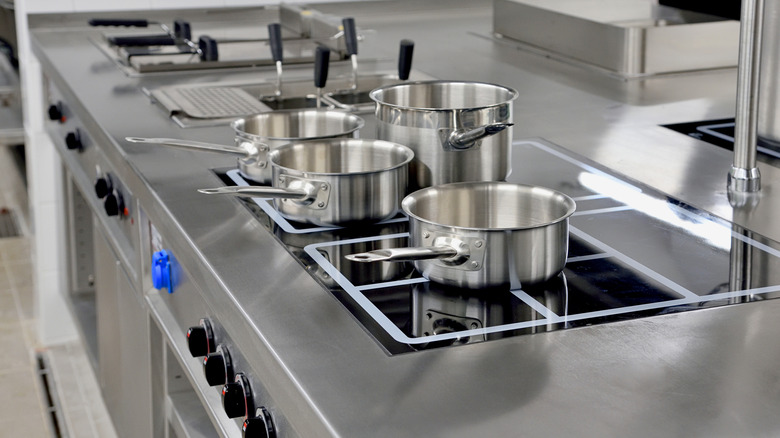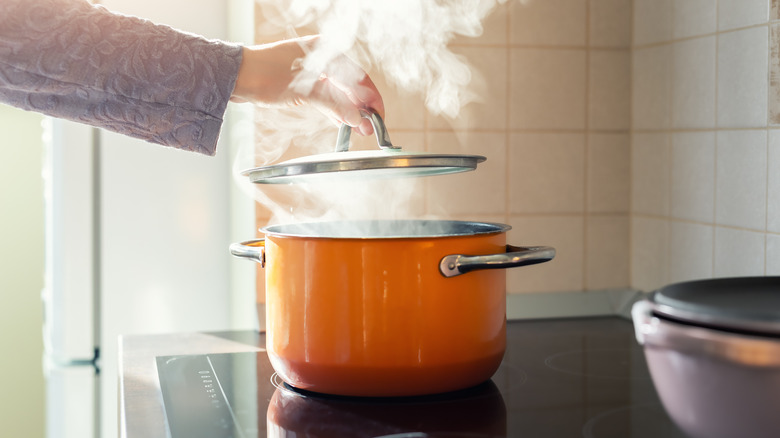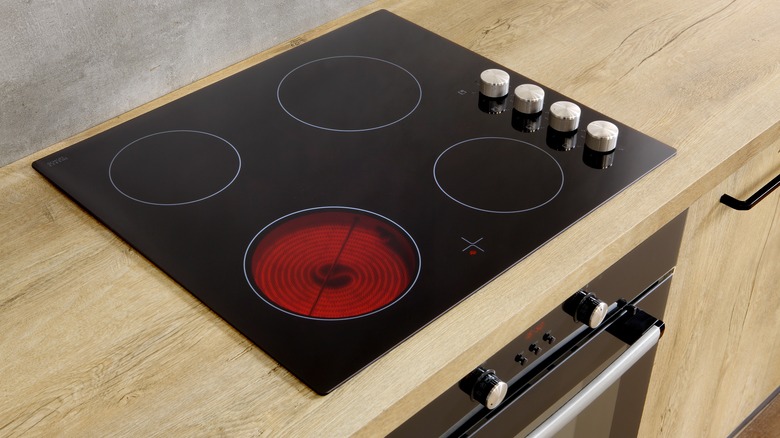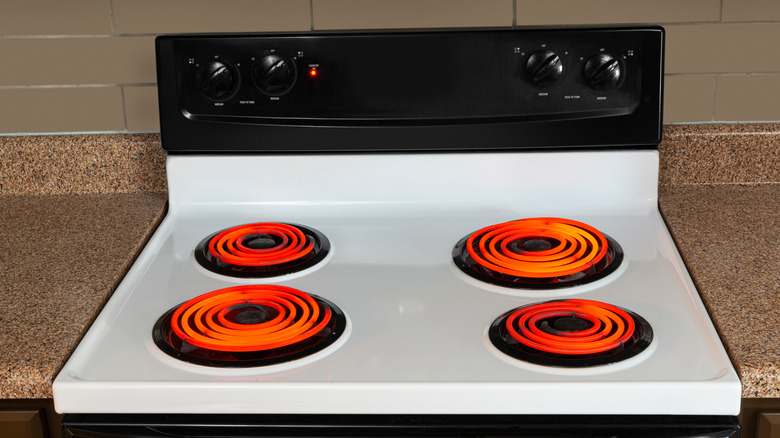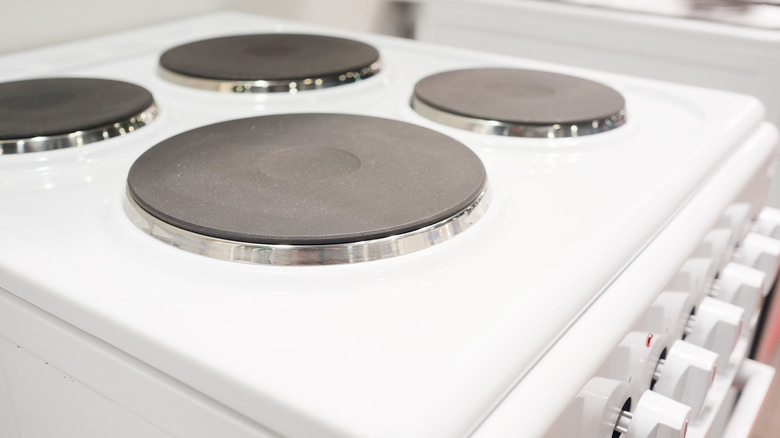How Much Does It Cost To Put In An Electric Stovetop?
Stovetops are a core feature in kitchens across the United States. Cooking centers around the combination of a stove and oven, and modern appliances can feature a combination of the two or a separate parts approach that gives the stove more versatility.
Installing a new electric stovetop is an important task for homeowners in the middle of a kitchen renovation — or those needing a replacement for an outdated or broken stove. Cooking simply can't take place without the function of this essential appliance. But installing a new stove can be done in a number of unique layouts, making the replacement process more in-depth than a simple one-for-one swap.
Fixr reports that the average cost to install a new stovetop is $650, with the lowest cost expected at around $375. One of the main features of the total cost is the size of your new range. Many homeowners operate a four-burner stovetop, but an equally likely setup for typical family homes may incorporate two or five burners. Depending on your cooking needs and the space available for the installation, selecting a new stovetop may be a simple endeavor that only centers on the brand or heating style (gas versus electric, or the addition of induction heating, for instance).
With these key features in mind, making the best decision about your electric stovetop replacement doesn't have to be a guessing game.
Factors for cost
When installing a new stovetop in your home, there are some obvious features to keep in mind that will impact the overall price of the unit and necessary installation. The primary factors driving cost revolve around the type of stove, size, and any required removal processes that act as prerequisites for the new installation.
Size
The number of heating elements that you need will play a major role in the final price that you can expect to pay. The more burners your new stovetop incorporates, the more expensive the purchase will be. Fixr estimates that a single burner option may run between $150 and $400, while a five-burner, 36-inch selection averages between $650 and $2,500.
The more cooking you do, the more stove area you'll likely need. For a family household, a four-burner setup may be the smallest overall footprint that can get the job done. Yet, for a single person or a studio apartment, a 21-inch, two-heating element installation may be a cost-effective selection that provides all the cooking surfaces required.
Consider the types of cooking and the number of pots and pans that typically make up your kitchen routine. For a pasta night, for instance, you may use two burners to cook the sauce (and any additions within it) and the pasta. However, this process can take three or more dedicated heat sources if you are making the entire meal from scratch. Pasta sauce can be an all-day affair or simply require an additional burner to allow the pot to simmer away while you prepare other elements of the mean (via The Mediterranean Dish).
Stovetop selection
Suppose you've already decided against the installation of a gas stovetop. In that case, the only choice left to make is whether you are going to make use of an induction cooking surface or a more traditional electric model. Induction cooking utilizes magnetic fields (powered by electricity) to boil water in half the time it takes a traditional electric model while also maintaining temperature regulation that makes burning delicate foods far more difficult (via The New York Times' Wirecutter). Induction ranges cost more to purchase than electric stoves. Fixr reports that electric cooktops run between $300 and $1,000, while induction stoves typically cost between $1,000 and $2,500. However, the difference is dramatic. LeafScore reports that induction stoves are far more energy-efficient than other options, and the speed and consistency with which cooking can be completed makes the induction stove a superior product overall.
It should be noted, though, that induction cooking requires steel or cast iron cookware to generate the magnetic field and work. Aluminum, copper, and ceramic pots and pans won't work with this type of stovetop. The New York Times' Wirecutter notes that this change isn't likely to be dramatic — since many articles of cookware in the typical household are already compatible — but checking your pots and pans with a magnet can help you identify how many of your existing pieces of equipment can be used if you're thinking of making the change.
Preparation and installation
Home X notes that installing a new electric stove typically costs between $100 and $200. This can rise beyond the standard charges if additional electrical work or cutouts are required. If you are changing size — replacing a two-burner with a four-burner model, for instance — then you may need to cut out a section of the existing countertop. This is somewhat straightforward if your counters are fabricated from wood (with a finish layer or woodblock effect on the top). However, if your home has granite, quartz, or any other slab counters, the job will become more in-depth, necessitating the assistance of a professional.
In any replacement job, you'll need to remove the old stove and prepare the surface for the installation. For anything that goes beyond the standard one-for-one swap, you'll want to bring in a professional to streamline the process and eliminate the potential for mistakes and damage.
Additional costs
In addition to the primary factors, you can expect to pay for the project with a few other factors in mind.
Heating element selection
Fixr reports that traditional electric stovetops come in three standard options for heat transfer. Older models (and some new additions) use coils for heating pots and pans on the stove. Alternatives to the coil setup include solid disk and smooth heating elements. Each of these options range from $300 to $450, $375 to $500, and $400 to $1,000, respectively. Coils are undoubtedly the most cost-friendly option, but the disk and smooth cooking surfaces provide a more aesthetically pleasing visual appeal. Disks are great for retaining heat after the burner has been turned off, making them useful for transferring residual heat and keeping dishes warm while you finish preparing other elements of a lunch or dinner.
Smooth worktops are typically made of glass or a single pane surface. They are easy to clean and look great in all household settings.
Ongoing operational costs
The cost to run an appliance should always factor into your decision-making process. Gas stoves are a favorite for some home cooks because they provide a unique controlled element to the cooking experience and are great for wok cooking, which benefits directly from the intense and immediate heat of an open flame (via Oven Via). However, paying for the gas that powers the culinary magic can add yet another expense to the household. Instead, an electric stove is more energy-efficient and can provide a greener experience for the home.
Induction cooking takes this a step further and is the most energy-efficient cooking option among the three types of stovetops, according to LeafScore.
Surface material
Lastly, the surface material of your stovetop can influence the price alongside burner variety and number. Fixr notes that stainless steel cooktop surfaces are a favorite among homeowners. They are really the only option when it comes to gas stoves and make for a visually stunning addition in the electric or induction format as well.
You might also consider a ceramic or enamel cooking surface instead when installing a smooth stovetop that makes use of either induction cooking or the traditional electric option.
Why you need a new stovetop
Adding a new stove to your kitchen can bring together a room renovation project or create a new functional feature in an existing space that isn't seeing a comprehensive facelift. The reasons for installing a new stovetop in your kitchen are numerous, but they begin with the obvious: Your existing stove isn't cutting it any longer.
Your old stove is old
An older stovetop may be missing knobs, lack the power that it once had to heat up pots and pans quickly, and more. Older stoves slowly become less efficient, and as a result, they are less effective at the task they've been given in your home. House Beautiful reports that if cared for properly, a kitchen stove should last about 13 to 15 years. If your home has made use of the same range for a decade or longer, you should start looking into replacement options for the appliance sooner rather than later.
Energy efficiency
A new stovetop is far more energy-efficient than an old one. Even if you are replacing your current stove with virtually the exact same product (a like branded model with the same number and type of burners), the newer appliance will take advantage of all the latest in technological advancements, making the newer item more efficient at heating up and cooling down than the old one.
Energy efficiency is an important consideration when it comes to managing household bills. Newer appliances are money savers over the long run, even as they bring larger upfront costs to the equation. What's more, an energy-efficient appliance is better for the environment, so this change allows you to provide in a small but meaningful way to your community while improving your experience and cash flow at home, per Consumer Reports.
Improve your culinary inspiration
Professionals in every industry tend to note that the tools used don't make the magic. A guitarist isn't suddenly better because she buys a new instrument, nor is a chef any more talented with top-of-the-line pans and knives in their arsenal.
The same goes for the cooking appliances that you use. However, there is something to be said about the way that these tools make you think and feel. New gear won't improve your existing talent, but it will stretch the way you think about the task at hand. A brand new stovetop can be the missing link in bringing joy back to the kitchen, rather than making cooking feel like a chore that should be done as quickly as possible. Cooking gives people immense feelings of accomplishment and satisfaction, according to Mind Food. Replacing an old stove with something new might be the perfect way to bring this feeling back into your home and kitchen.
Benefits of installing a new electric stovetop
The benefits of installing a new electric stovetop are immense. From the resale value that this change brings to the aesthetic improvement that new appliances provide to a room, there are a number of great reasons, benefits, and considerations that all play a role in the decision to replace an old kitchen stove.
Improve the look and feel of your kitchen
The visual appeal of your home is a crucial element that can be hard to pin down precisely. The kitchen often needs to strike a balance between functionality and beauty, but older appliances rarely fit into this aesthetic. Installing a new stovetop in your kitchen is a big step in the right direction when it comes to making visual as well as functional upgrades to the space. Installing a new cooking surface can give you a scaled-down profile that does away with the older coil model (or perhaps brings it back for a vintage flair). Making a functional change often places the visual aspects of the update in a backseat role, but when it comes to cooking appliances like the stovetop, both aspects take center stage, per Remodelista.
Boost the home's resale value
Making changes and improvements to a home will almost always improve its resale value. House Tipster notes that a new cooking surface can improve the resale value of your property by making the kitchen look modern. Energy-efficient models are great for attracting the attention of interest buyers. Because of the immense demand that a stovetop must accommodate, installing a high-quality stove in the kitchen can act as the leverage needed to sway a buyer that may still be on the fence.
